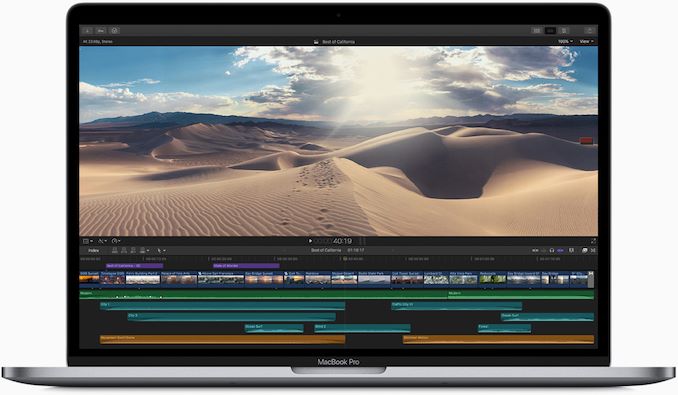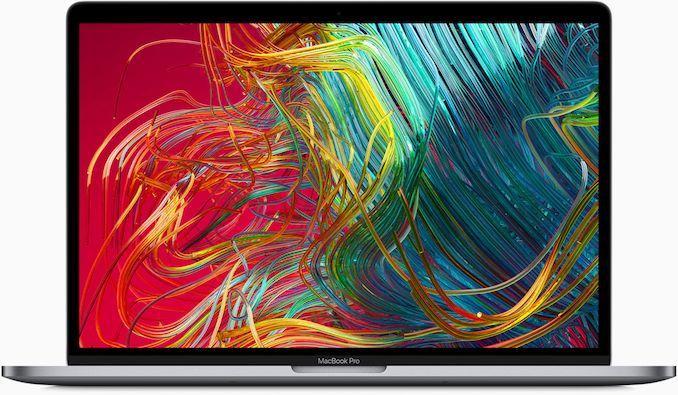Apple Refreshes 13 & 15-Inch MacBook Pros for 2019: Adds 8-Core Intel CPUs & Revised Keyboard
by Anton Shilov on May 22, 2019 1:30 PM EST- Posted in
- Laptops
- Apple
- MacBook Pro
- Notebooks
- Core 9th Gen
- Coffee Lake-H

Apple on Tuesday introduced refreshed versions of its MacBook Pro 13-inch and 15-inch laptops, updating the machines to use Intel's latest 8th and 9th Gen Core processors, as well a further refinement to the company's butterfly keyboard switches. In particular, Apple is now offering Intel's 8 core processors as an upgrade option with the 15-inch MacBook Pro, marking the second time in a year that Apple has added more cores to this laptop, with Apple touting that the newest model is up to 40 percent faster than its predecessor. Otherwise, these new 2019 models are pure spec-bumps over the 2018 models, offering faster CPUs but are otherwise unchanged from their predecessors as far as displays, dimensions, and other specifications are concerned.
This refresh comes surprisingly swiftly for Apple, who over the last few years has taken a slower track in refreshing its laptops. Intel only announced their 45 Watt 9th Gen Core mobile parts a month ago, so this is relatively quick for Apple. Meanwhile the 13-inch model doesn't get quite the same boost here, but its updated 8th Gen Core processor options are faster than the models it replaces.
Along with the new CPUs the refreshed laptops are also introducing a further update to Apple's butterfly keyboard switches, which have gone through a few generations of tweaks now in response to reliability issues. According to The Verge, while Apple isn't calling this a fourth-generation keyboard, the company has none the less using a new material in part of the butterfly mechanism to further reduce issues with the keyboard. Despite Apple's efforts thus far, issues have persisted with the butterfly switches, so time will tell how the latest iteration does.
Otherwise, as noted above the base specifications for the other aspects of the MacBook Pros haven't changed. In the case of the 15-inch mode, this means a 15.4-inch display supporting a 2880x1800 resolution (along with DCI-P3 color gamut as well as True Tone technology), accompanied by AMD’s Radeon Pro 555X/560X-series or Radeon Pro Vega GPUs, with the top-of-the-range model configurable with the Radeon Pro Vega 16 or 20 chip. Meanwhile, DRAM and SSD options include 16 GB of RAM and a 256 GB SSD on the base model, with 32 GB of DDR4 RAM and SSDs ranging from 512 GB to 4 TB available as upgrades.
| MacBook Pro 15-Inch 2019 Models | ||||
| Model | 6-Core | 8-Core | ||
| CPU | 2.6 GHz Core i7-9750H 6 CPU Cores (Coffee Lake) Configurable to Core i9-9980HK |
2.3 GHz Core i7-9880H 8 CPU Cores (Coffee Lake) Configurable to Core i9-9980HK |
||
| GPU | Intel UHD Graphics 630 + AMD Radeon Pro 555X (4GB) Configurable to Radeon Pro 560X with 4 GB of GDDR5 memory |
Intel UHD Graphics 630 + AMD Radeon Pro 555X (4GB) Configurable to Radeon Pro Vega 16 with 4GB of HBM2 memory or Radeon Pro Vega 20 with 4GB of HBM2 memory |
||
| Display | 15" 2880 x 1800 IPS LCD DCI-P3 Gamut True Tone |
|||
| Memory | 16 GB DDR4-2400 Configurable to 32 GB of DDR4-2400 |
|||
| SSD | 256GB PCIe SSD Configurable to 512GB, 1TB, 2TB, or 4TB SSD |
512 GB PCIe SSD Configurable to 1TB, 2TB, or 4TB SSD |
||
| Touch Bar | Yes | |||
| I/O | 4x Thunderbolt 3 (supports DP1.2 & USB 3.1 Gen 2 modes), 3.5mm Audio |
|||
| Battery Capacity | 83.6 Wh | |||
| Battery Life | 10 Hours | |||
| Dimensions | 1.55 cm x 34.93 cm x 24.07 cm | |||
| Weight | 4.02 lbs (1.83 kg) | |||
| Price | $2399 | $2799 | ||
Despite the fact that Apple now offers more powerful hardware with its 2019 15-inch MacBook Pro, the company still outfits the machines with an 83.6 Wh battery that is rated for up to 10 hours of operation. Of course, real-world will depend on usage model, display brightness, and so on.
As far as connectivity is concerned, the new Apple MacBook Pro 15-inch laptops feature 802.11ac Wi-Fi with Bluetooth 5.0 as well as four Thunderbolt 3 ports supporting up to four 4Kp60 displays or two 5Kp60 monitors. Besides TB3 connectors, the notebooks are equipped with a 3.5-mm headset jack.
The latest 15.4-inch laptops from Apple are already available directly from the company’s website as well as retail outlets. The model with a six-core CPU and the Radeon Pro 555X starts at $2,399, whereas the SKU with an eight-core CPU and the Radeon Pro 560X starts at $2,799.
| MacBook Pro 15-Inch (Base Model) | ||||||
| Model | 2019 | 2018 | 2017 | 2016 | ||
| CPU | 2.6 GHz Core i7-9750H 6 CPU Cores (Coffee Lake-R) |
2.2GHz Core i7-8750H 6 CPU Cores (Coffee Lake) |
2.8GHz Core i7-7700HQ 4 CPU Cores (Kaby Lake) |
2.6GHz Core i7-6700HQ 4 CPU Cores (Skylake) |
||
| GPU | Intel UHD Graphics 630 + AMD Radeon Pro 555X (4GB) | Intel UHD Graphics 630 + AMD Radeon Pro 555X (4GB) | Intel HD Graphics 630 + AMD Radeon Pro 555 (2GB) | Intel HD Graphics 530 + AMD Radeon Pro 450 (2GB) | ||
| Display | 15" 2880 x 1800 IPS LCD DCI-P3 Gamut True Tone |
15" 2880 x 1800 IPS LCD DCI-P3 Gamut |
||||
| Memory | 16GB DDR4-2400 | 16GB LPDDR3-2133 | ||||
| SSD | 256GB PCIe SSD | |||||
| Touch Bar | Yes | |||||
| I/O | 4x Thunderbolt 3 (supports DP1.2 & USB 3.1 Gen 2 modes), 3.5mm Audio |
|||||
| Battery Capacity | 83.6 Wh | 76 Wh | ||||
| Battery Life | 10 Hours | |||||
| Dimensions | 1.55 cm x 34.93 cm x 24.07 cm | |||||
| Weight | 4.02 lbs (1.83 kg) | |||||
| Price | $2399 | $2399 | $2399 | $2399 | ||
As for the 13-inch MacBook Pro, things are far more straightforward. Since there haven't been any core count increases, we're just looking at CPU frequency bumps. While we haven't been able to identify the specific SKU Apple is using in the base model, it's a 2.4GHz base/4.1GHz boost part, up from the 2.3Ghz/3.8GBz processor found in the 2018 model. Similarly, the high-end model now boats a Core i7 2.8GHz/4.7GHz CPU.
Pricing on the two 13-inch models remains unchanged. The base model starts at $1,799, and the high-end model at $2,099.
| MacBook Pro 13-Inch w/Touch Bar (Base Model) | ||||||
| Model | 2019 13-Inch | 2018 13-Inch | 2017 13-Inch | 2016 13-Inch | ||
| CPU | 2.4GHz/4.1GHz Core i5-8???U 4 CPU Cores (Coffee Lake) |
2.3GHz/3.8GHz Core i5-8259U 4 CPU Cores (Coffee Lake) |
3.1GHz/3.5GHz Core i5-7267U 2 CPU Cores (Kaby Lake) |
2.9GHz/3.3GHz Core i5-6267U 2 CPU Cores (Skylake) |
||
| GPU | Intel Iris Plus 655 (128MB eDRAM) |
Intel Iris Plus 655 (128MB eDRAM) |
Intel Iris Plus 650 (64MB eDRAM) |
Intel Iris 550 (64MB eDRAM) |
||
| Display | 13" 2560 x 1600 IPS LCD DCI-P3 Gamut True Tone |
13" 2560 x 1600 IPS LCD DCI-P3 Gamut |
||||
| Memory | 8GB LPDDR3-2133 | |||||
| SSD | 256GB PCIe SSD | |||||
| Touch Bar | Yes | |||||
| I/O | 4x Thunderbolt 3 (supports DP1.2 & USB 3.1 Gen 2 modes), 3.5mm Audio |
|||||
| Battery Capacity | 58 Wh | 49 Wh | ||||
| Battery Life | 10 Hours | |||||
| Dimensions | 1.49 cm x 30.41 cm x 21.24 cm | |||||
| Weight | 3.02 lbs (1.37 kg) | |||||
| Price | $1799 | $1799 | $1799 | $1799 | ||
Related Reading:
- Apple Refreshes Mac Laptops: Pro, Vanilla, & Air All Get New CPUs
- Apple Announces 4th Generation MacBook Pro Family: Thinner, Lighter, with Thunderbolt 3 & “Touch Bar”
- Apple Announces 2018 MacBook Air: Entry-Level Laptop Gets Essential Refresh
Source: Apple











30 Comments
View All Comments
bubblyboo - Wednesday, May 22, 2019 - link
8-core in same chassis = race to throttlebrian_Sal05 - Thursday, May 23, 2019 - link
That's my main concern, but nobody seems to be talking about itweb2dot0 - Saturday, May 25, 2019 - link
Initial reviews says NO PROBLEM. Their 8-core chassis have been retrofitted with a high speed fan to dissapate the heat.Retycint - Sunday, May 26, 2019 - link
TechRadar's review reports an average clockspeed of 2.99GHz, dropping down to a minimum of 2.50GHz, during a 1hr 13 mins video encoding session. Which isn't bad, by all means, but it's still throttling quite a bit.And before anyone hits me with the "oh it's not running below base clock hence it's not throttling", base clock is irrelevant because Intel changes the base clock at will, in order to squeeze it into the 45W TDP (base clock went from 2.9 to 2.4GHz for i9-8950HK and i9-9880HK respectively). So base clock is a largely irrelevant metric and it would be foolish to use base clock as a metric for throttling
Retycint - Sunday, May 26, 2019 - link
Admittedly, this issue is not unique to Apple. The XPS 15 i9-8950HK config has also shown similar throttling, and no doubt the 9880HK variant (when it releases) will throttle even more, due to 2 additional cores.So perhaps the moral of the story is to not buy an i9 fitted inside a thin and light chassis unless your workload really, really, benefits from the 2 extra cores, versus higher clockspeeds for the i7 variant
solarisking - Wednesday, May 22, 2019 - link
It's un-fu****g-believable that Apple still sells a $2399 laptop with only a 256GB SSD. AND has the gall to charge 200 bucks on top of that to upgrade to a 512GB SSD. No thanks. If Apple doesn't change their ways by this time next year I'll likely be leaving the Apple ecosystem.Ninhalem - Thursday, May 23, 2019 - link
Why are you so surprised? This is the same pricing model as more than a decade ago. You're not being charged for just the hardware but the tight knit integration between the hardware and the software. You're not going to get the consistent level of performance from any other machine a decade after the manufacture date.sa666666 - Friday, May 24, 2019 - link
What does "tight-knit integration" have to do with charging $200 extra for 256GB SSD? How does integration in any way justify the huge price of a component upgrade that doesn't use Apple software at all?Not sure if this is satire (it very well may be), but if it isn't, it just goes to show that Apple users will swallow anything.
solarisking - Friday, May 24, 2019 - link
That's not true. My 2012 MBP was $2,000, $400 less than the entry model 15" MBP. Apple even briefly had an $1800 version for a few years. The Apple premium with comparable parts to PCs has historically been around $200. That's fine by me but when the entry level 15" is $2400 I have to balk at the egregious pricing. Not to mention faulty keyboard design and lack of ports.web2dot0 - Saturday, May 25, 2019 - link
Try find a 8-core i9 with 87Wh laptop in 4lbs form factor. Then complain about 256GB SSD.